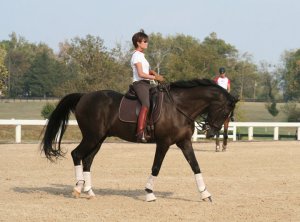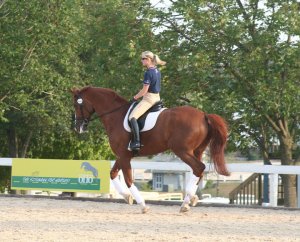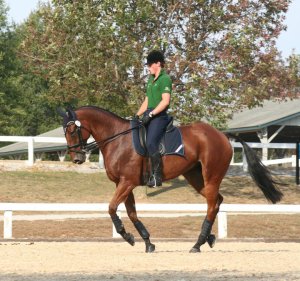I just found this article in the Spring 2010 edition of the Eventing USA 2.0 magazine written by Captain Mark Phillips, Chef d’Equipe and Technical Advisor of US Eventing. This is an extract of his article which is on pages 26 & 27 of the Eventing USA 2.0 magazine.
The Pine Top accidents brought many issues into focus. Not least of which is the new rule in this country that if it is possible to ‘pin’ or make a fence frangible, it now has to be done. The pins are free, courtesy of the USEF, so there are no excuses in the future.
Secondly, the concussion incidents at Pine Top highlight once again the inadequacy of the USEF ‘return to play’ policy. In Europe it’s very simple; if you have a concussion you are suspended for three weeks unless you go to a neurosurgeon and have an ‘impact’ test. Only then can you get back to compete sooner. Rusty Lowe who has done so much for safety in the sport of eventing in the U.S., has been a strong proponent of this rule, and I understand that Malcolm Hook, (USEF National Safety Officer and USEA VP Competitions) and the USEA Safety Committee led by USEA Vice President, Carol Kozlowski, are planning to put this proposal on the agenda for an upcoming meeting of the Board of Governors and fully expect it to go forward as a rule change to the USEF this year.
In the same vein, I believe that a USEA ICP certified coach is essential for all riders competing at USEA events. After all, everyone is in agreement that the fastest way to a safer sport is through better coaching. I fully expect that in ten years all coaches at USEA competitions will be ICP certified and I call upon the leadership of the USEA to work towards this goal. Becoming certified certainly shouldn’t cramp anyone’s style if they are a good enough coach. In the meantime, I stand in the collecting ring and warm-up areas feeling immensely sorry for all those people paying for and listening to often dangerous advice from their coaches at USEA affiliated events.
Mark and many of his contemporaries including Lucinda Green have been very public and vocal that one of the most critical steps to increasing safety in Eventing is to lift the level and quality of coaching. Many riders come to Eventing from numerous different avenues including starting out as adult riders. Fewer are having grown into the sport through Pony Club where a focus is on horsemanship not just learning to ride.
There is also a movement in some countries that teaching riders to fall safely can help to reduce injuries. Personally, I think this may help for smaller falls but when your in a rotational fall, it is not your landing that is the issue but the horse landing on you that causes the issue.
So YES, it is definitely important to teach riders to become better “Horseman”, and learning to fall cannot hurt (well it might, but a great skill to have). But reducing rotational falls is simply the area of focus which will reduce the number of serious injuries and fatalities. The most recent death in our sport was a 16 year old young lady in Russia (an emerging Eventing Nation), read my story here.
We all need to consider the factors of “Return to Play” and how having a heady injury can affect your performance, not just on the day but in the weeks following. For instance in the UK, British Eventing will place any rider who has had a head injury that results in a loss of consciousness on a mandatory minimum 21 day “Medical Suspension”. At the end of the suspension written approval from a medical specialist (i.e. Neurologist) is required and must be approved by British Eventing before a rider can return to competition at both BE and FEI events.
Here is an extract from the BE Rule Book explaining a “Medical Suspension”
vii. Falls and Suspensions
Falls – Any Competitor who has had a fall or sustains a serious injury anywhere at the competition site must see the Doctor and be passed fit to ride before riding that horse in a further test (Show Jumping or Cross Country) or before riding any other horse. After a fall in the dressage, the BE Steward may, after discussion with the ambulance personnel, give permission for a rider to ride again, if no doctor is present.
Suspensions – The doctor may decide that the Competitor is so badly hurt that he should be medically suspended. Such a suspension will either be for a stated period or of unspecified duration. Details will be recorded on the rider’s BE Medical Card.
In the case of a head injury (or other injury likely to cause concussion) the following applies:
a. No loss of consciousness and no sign of concussion – No mandatory suspension;
b. No loss of consciousness but with brief symptoms of concussion (all symptoms of concussion must have resolved within 15 minutes both at rest and exercise) – minimum of 7 days mandatory suspension;
c. Any loss of consciousness, however brief, or symptoms of concussion persisting after 15 minutes – minimum 21 days mandatory suspension.
The day of injury counts as the first day of the suspension period.
After suspension the rider may not compete in any competition to which these rules apply nor in any FEI competition until:
a. Any period of suspension, whether stated to be minimum or not, has elapsed and the rider has written confirmation that he is fit to compete in Events from a Registered Medical Practitioner and the contents of the written confirmation have been communicated to BE;
OR
b. The rider has written confirmation that he is fit to compete in Events from a Registered Medical Practitioner accepted as appropriate (e.g. a neurologist) by the Chief Medical Officer and the contents of the written confirmation have been communicated to BE.
If a rider is taken to hospital from an Event without having his Medical Card completed by the doctor, a minimum 21 days mandatory suspension shall automatically apply in respect of a head, or other, injury likely to cause concussion. In the case of other injuries the rider may not compete until he has obtained written confirmation that he is fit to compete in Events from a Registered Medical Practitioner and the contents have been communicated to BE.
A copy of any written confirmation of fitness to compete must be supplied to BE if required by the Chief Executive.
A rider who has been medically suspended from competition must supply written confirmation of fitness to compete to BE office before resuming competition.
Alternatively a copy of the document may be faxed to Carolyn Simm (02476 697235) or scanned and emailed to carolyn.simm@britisheventing.com
Some people consider this rule to be too tough, a Medical Suspension rule similar to this was actually introduced into the FEI rules on 1 July 2009. This rule 519.3 was then removed (in the main) on 1 January 2010. No public explanation has been given for this reversal.
So what can you do as a rider to help improve safety in Eventing.
Start with yourself
- Do you have an experienced and qualified instructor? If not, get one
- Do you have even experience and appropriate horsepower to be riding at the level you do?
- Have you got and always wear the best quality safety helmet you can afford? Read this to see what happened to Oli Townend’s helmet after his Rolex fall.
- Do you have a top quality Back Protector Vest? The best you can afford
- Do you have an air jacket? If you can afford to Event you can’t afford not to wear one, if may save your life! Point Two or Hit Air Airbag Vest
- If you see something on the Cross Country Course or for that matter at an Event that you are not sure about, find the Technical Delegate and ask, we are not scary and better safe than sorry.
We all need to be part of the solution, so if you are not sure please speak up, for the sake of our sport.







